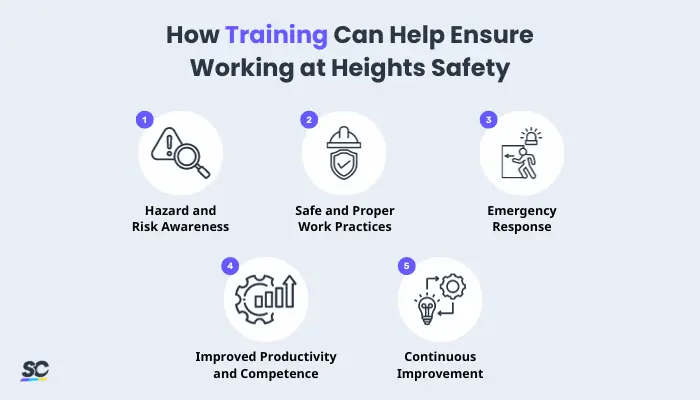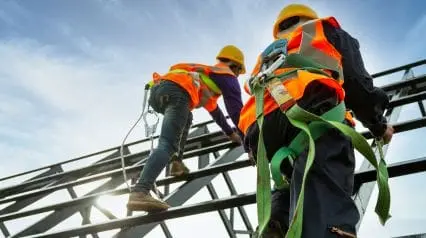What is Working at Heights Training?
Working at heights training is a specialized form of occupational safety training designed to educate individuals on how to safely perform tasks and activities at elevated positions or in environments where there’s a risk of falling. This type of training is essential in various industries, including construction, maintenance, roofing, and more, where employees may encounter situations that require them to work at heights above ground level.
What are the Key Challenges of Working at Heights?
Working at heights presents a range of challenges and risks that can impact both worker safety and productivity. Here are some key challenges associated with this nature of work:
- Fall Hazards – can result in severe injuries or fatalities
- Unstable Surfaces – can make it challenging for workers to maintain their balance and stability while working at heights
- Weather Conditions – can create additional hazards and increase the likelihood of accidents
- Inadequate Training – may lead to workers not using fall protection equipment correctly, assessing risks accurately, or following safety procedures
- Lack of Supervision – can result in unsafe practices going unnoticed
- Complacency – can lead to lapses in safety precautions
- Communication Challenges – may result in errors and accidents
How Training Can Help Ensure Working at Heights Safety
Training plays a pivotal role in ensuring working at heights safety. It equips workers with the knowledge, skills, and awareness they need to perform tasks at elevated positions safely.

How Training Can Help Ensure Working at Heights Safety
Conducting rigorous training also helps the management devise and implement emergency response plans and effective strategies to minimize safety risks. In addition to that, here’s how training can help ensure working at heights safety:
Hazard and Risk Awareness
Training helps workers recognize and understand the various risks associated with working at heights. This includes identifying potential hazards such as unstable surfaces, slippery conditions, and fall hazards.
Workers also learn how to conduct thorough risk assessments before starting any task at height. They become skilled not just at identifying specific hazards in their work environment but also at taking necessary precautions to mitigate them.
Safe and Proper Work Practices
Training provides comprehensive guidance on the correct selection, use, and maintenance of fall protection equipment. These can be done by teaching best practices for working at heights to prevent accidents caused by improper procedures.
Emergency Response
Training includes emergency procedures for various scenarios, such as rescuing a fallen worker or responding to accidents. This way, workers can learn how to react quickly and effectively in critical situations, potentially saving lives.
Improved Productivity and Competence
Through hands-on training and practical exercises, workers gain confidence in their ability to work at heights safely. These also help them become more competent in performing their tasks, reducing the likelihood of errors and accidents.
In addition to that, training ensures that workers are aware of and understand relevant safety regulations and industry standards to maintain legal compliance and avoid penalties.
Continuous Improvement
A commitment to safety cultivated through training contributes to a positive safety culture within the organization. This is because continuous training and refresher courses keep workers up-to-date with evolving safety practices, equipment, and regulations, ensuring that their knowledge remains current.
Improve your EHS Management
Cultivate a safe working environment and streamline compliance with our EHS solutions.
Explore nowWhat to Cover
When conducting working at heights safety training, it’s essential to tackle a comprehensive range of topics, including the following:
- Risk Assessment:
- Identifying potential risks associated with working at heights
- Assessing risks and determining appropriate control measures
- Understanding the importance of pre-task planning
- Fall Hazards:
- Recognizing different types of fall hazards
- Understanding the consequences of falls
- Fall Protection Equipment:
- Types of fall protection equipment (e.g., harnesses, lanyards, lifelines, anchors)
- Selection, correct fitting, and adjustment of appropriate equipment
- Anchorage Points:
- Identifying suitable anchorage points for fall protection systems
- Ensuring the strength and stability of anchorages
- Proper use of anchor connectors and components
- Safe Work Practices:
- Setting up and using guardrails, safety nets, and scaffolding
- Proper procedures for accessing and exiting elevated work areas
- Safe use of access equipment like ladders and aerial lifts
- Emergency Procedures:
- Responding to accidents and emergencies at heights
- Rescue procedures for injured or suspended workers
- First aid and communication during emergencies
- Compliance with Regulations:
- Familiarity with relevant safety regulations and industry standards
- Adherence to legal requirements for working at heights
- The consequences of non-compliance, including potential fines and penalties
- Equipment Inspection and Maintenance:
- Regular inspection of fall protection equipment for wear, damage, or defects
- Proper storage and care of equipment
- Reporting and addressing equipment issues
- PPE:
- Use of additional PPE as necessary
- Ensuring that PPE is compatible with fall protection gear
- Hands-On Training:
- Practical exercises to allow participants to apply what they’ve learned
- Hands-on experience with setting up fall protection systems and using equipment
- Case Studies and Real-Life Examples:
- Sharing real-life incidents and accidents related to working at heights
- Analyzing case studies to understand what went wrong and how to prevent similar incidents
- Supervision and Accountability:
- The role of supervisors, safety officers, and training personnel in ensuring safety
- Individual and collective responsibility for safety within the workplace
- Ongoing Training and Refresher Courses:
- Reinforcing the importance of continuous learning and staying updated on safety practices
- Encouraging participants to periodically refresh their knowledge and skills
- Written Policies and Procedures:
- Providing access to written safety policies and procedures related to working at heights
- Encouraging participants to consult these documents as needed
- Communication and Reporting:
- Emphasizing the importance of clear communication between workers, supervisors, and management
- Reporting unsafe conditions, near misses, and incidents promptly
To help you ensure all key topics are covered and well-discussed during training, using tools like checklists and templates to streamline progress documentation is also highly recommended.
Create Your Own Working at Heights Safety Training Checklist
Eliminate manual tasks and streamline your operations.
Get started for FREEHow to Conduct a Working at Heights Training
Implementing practical training is crucial for ensuring the safety of workers who perform tasks at elevated positions. Here’s a step-by-step guide on how to conduct such training:
- Determine which employees need working at heights training and assess the specific risks associated with their tasks and work environments.
- Design a comprehensive working at heights training course that covers all essential aspects and is tailored to the specific needs of your industry and workplace.
- Collect all the necessary and up-to-date training materials and equipment for hands-on exercises.
- Choose instructors who have expertise and experience in working at heights and who are capable of effectively conveying the training content.
- Plan the training sessions, taking into account the availability and schedules of the employees. Also, ensure that you have suitable training facilities, as needed.
- Cover holistic topics and provide hands-on training exercises to allow participants to practice what they’ve learned.
- Conduct assessments to evaluate participants’ understanding and skills and provide feedback to help participants improve.
- Continuously update training modules and courses to reflect changes in regulations, equipment, and best practices. Also, conduct regular toolbox talks on working at heights safety and encourage employees to participate in refresher courses.
- Maintain detailed records of training sessions for compliance and auditing purposes.
- Seek feedback from participants to identify areas for improvement in the training program. Use such information to refine and enhance training efforts continuously.
To help standardize the training process in your organization, consider using tools like SafetyCulture (formerly iAuditor)’s Training. This innovative solution allows you to create, deliver, and track working at heights training courses to ensure standardization of best practices and safety measures efficiently.




